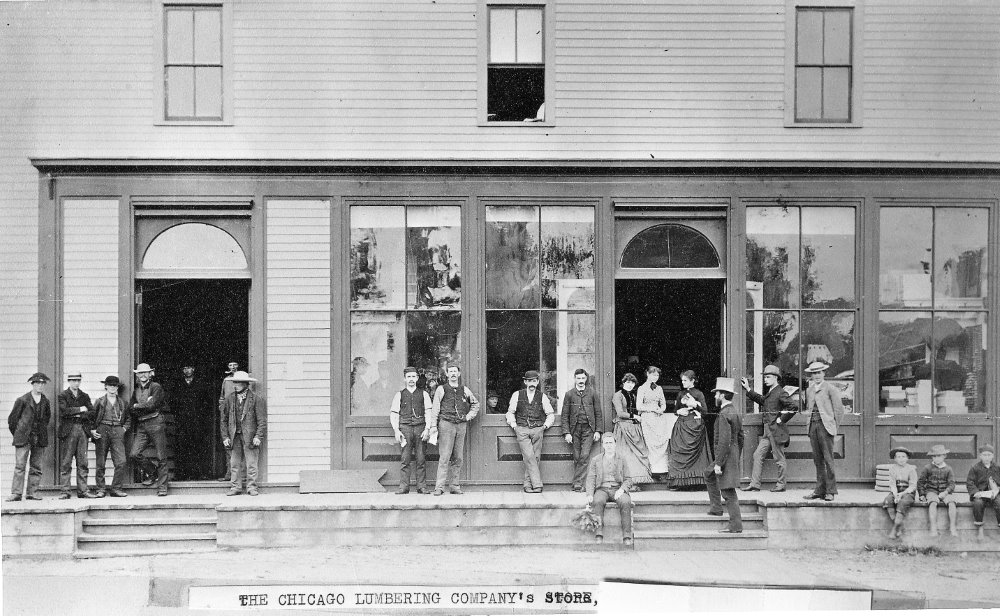The first Chicago Lumbering Company general store was built in the early 1870’s near the old saw mill. The company store was the only place to purchase the basic necessities. August Klagstad remembered his mother buying denim at the company store which she used to sew jackets and overalls. The few hundred pioneer residents of Manistique depended on the store to meet their most basic needs, including their daily bread. The store was stocked with a large number of provisions in the fall to provide for the residents and camp employees during the long winter months. Then, on the bitterly cold evening of January 13, 1881, an unbelievable catastrophe occurred. The company store burned to the ground.

The new Chicago Lumbering Company Store erected during the spring and summer of 1881 to replace the store burned in January. Photo courtesy SCHS, William Crowe Collection.
Built for function rather than beauty, the store was a simple two-story, frame building. The stock included dry goods, clothing, shoes, boots and groceries. During the winter, heat was provided by a huge box stove fueled by firewood cut in 4-foot lengths. A long stove pipe ran up from the stove through the roof. There was no chimney. The stove itself was set in a sandbox, which was a common practice in the late 19th century.
One frigid January evening the stove became overheated and the stove pipe set fire to the roof, resulting in the total destruction of the building. Only a small portion of the contents were rescued from the flames.
William Cowell, C. L. Co. Mill Superintendent, arrived at the store in the early stages of the fire. He ordered R. B. Waddell to take some men and remove about 500 pounds of black powder stored underneath some tables on the second floor. It was a dangerous assignment, but was carried out without hesitation. Through smoke and flames, the black powder was successfully extracted from the store before it could explode.
Manistique had no fire suppression equipment in 1881, and as residents gathered around the burning building, they threw snowballs in a futile effort to quell the flames. The heat from the fire melted the deep snow surrounding the building and created a pool of mud and water. The workers, supplied with rubber boots from the burning building, labored feverishly to salvage what little they could from the relentless flames.
The next morning the reality of the situation began to sink in for the residents of the village. The ships that normally brought supplies to the company store would not arrive again until spring, which was several months away. The winter of 1881 would be a winter of want.
The only link to the outside world was provided the Chicago and Northwestern R.R. Station at Brampton, Michigan in Delta County. The station was opened to Manistique by a stage line and wagon trail during the summer. The C. L. Company sent sleighs and teams of horses to Brampton to buy what food they could to feed the residents of the town, and the men in the lumber camps. Pioneer Manistique resident Alice Miller (nee Alice Quick) recalled those times: “By bringing a little from time to time by sleigh they managed to get along. Needless to say, there was a warm welcome for the first boat in the spring.”
The construction of a new company store began in the spring of 1881. It stood in what is now the former Ford dealership car lot across from Triangle Park. The new building was much more elaborate than its predecessor. Heat in winter was provided by two box stoves situated in the basement. The two story building housed a large general store on the first floor along with offices for the lumber company bosses. The second floor housed the clothing and carpet departments. There were boarding rooms for the general store clerks above the first floor offices.
The company store was one of the few places in the village where people congregated during the week, especially as the post office was located there, under the staircase in the hallway. Men would gather at the store after their shifts at the mill. On paydays, a long line of men stretched outside the building, all the way to the street, waiting to be paid their wages.
The Chicago Lumbering Company store continued to serve the community for many years. The building was sold in 1917 to John Hallen, who remodeled the building and established the Park Hotel. The venerable structure was sold for a final time in 1966 to the Alex Creighton Company and was later demolished.

The Park Hotel greeted guests from 1917-1966. It was owned by the John Hallen family. SCHS Photo.
